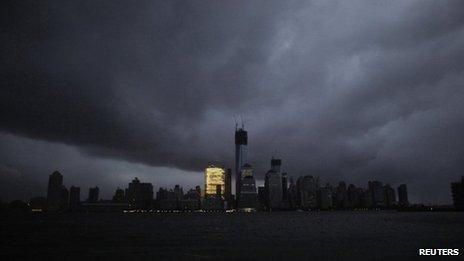Storm Sandy: New York's dark and bright sides
- Published

My taxi driver had already made heroic efforts to reach my house in Brooklyn, New York, but all I could think of as we headed back into the traffic gridlock was the mayor's car-pooling edict: only vehicles with three or more passengers would be allowed across the bridges into Manhattan.
Fortunately, extra people were not hard to find. A queue of thousands snaked around a sports arena near my home, one of the designated pick-up points for buses making the same journey. Before long, I was crossing the Brooklyn Bridge wedged between four strangers.
It is day four of the superstorm crisis and the city is shuddering back to life - but slowly.
Transport is one of the main problems. Part of the subway system that is the lifeline of the city has reopened, but no trains are running in the crucial business hub of Lower Manhattan, where the electricity is still out, or under the East river to the outer boroughs, because the tunnels are still flooded.
It is taking longer to pump out the water because of the power outage, which is also one of the reasons that petrol stations are closing: officials say 50% have shut in New York City, 80% in New Jersey.
So on top of everything else, there is a looming fuel crisis, with car services and taxi companies pulling vehicles off the road, and long lines forming at the stations still open.
The power failure has virtually shuttered Lower Manhattan and produced a host of survival stories from residents who have not found shelter elsewhere.
Ruben Santiago, the superintendent of a block of flats at West 14th Street and 7th Avenue, told me his building was also without water because there was no electricity to run the pumps, and more than 50% of the residents had decamped.
Marcia Sikowitz: "I had three sons, now I have two"
"There's nothing else we can do," he said. "I just check on the seniors left in the building, make sure they have food and water, try to make them as comfortable as possible and hope for the best."
The electricity company, Con Edison, has restored power to more than 200,000 customers since the storm and says it is on track to repair the grid in Manhattan by Saturday.
Not a moment too soon for Paul Spina, a retired art teacher in Chinatown who says he has to clean his teeth by torchlight, or Mark Collager, who like other normally mobile and super-connected New Yorkers, feels like he is in a vacuum.
"It kinda stinks that there's no cell phone service," he said. "So you're cut off from the world.
"And there are no street lamps anywhere, so at night it's kind of like fend for yourself, we walk around with flashlights. It's like the 1920s."
Many residents on Long Island have had their homes destroyed
The need to charge mobile phones and computers brings New Yorkers from Lower Manhattan up to the new dividing line that separates them from Upper Manhattan, where everything is working.
I have come across people piggy-backing off the power of a media truck - with permission, they assured me.
The same is true in some restaurants and banks, which are giving free access to their electricity outlets, although others are charging for the service.
In these unusual times there are many stories of people pulling together: one man cycling home from Uptown where he had gone to collect food for a neighbourhood barbecue in the darkened East Village; bars that operate by candlelight and go Uptown for ice to keep the beer cold; free massages offered to help ease some of the stress.
When the sun goes down, crossing the line between the City of Light and the City of Darkness is eerie, almost post-apocalyptic: moving within minutes from the bright lights of Times Square to the narrow unlit streets of the Financial District with the looming outlines of skyscrapers towering overhead.
A strange journey to take after a strange day. Perhaps by tomorrow I will have to be doing it by bicycle.